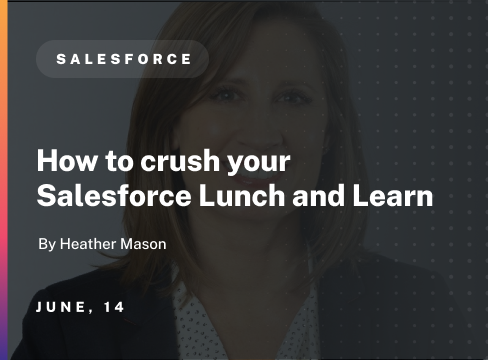Heather Mason is the Founder of ISV Accelerators, a consulting company that guides high potential Salesforce ISV Partners to quickly maximize their partnership and minimize their ramp time in the ecosystem. She has 10 years of experience in the Salesforce ecosystem, both as an ISV partner and a Salesforce employee, and she has seen her fair share of Lunch and Learns. In this article, she will explain the value of, and what to expect from a (good) Salesforce Lunch and Learn, share best practices, and give you an example of a great one!

The opportunity behind a Salesforce Lunch and Learn
Goal: The goal of a Salesforce Lunch and Learn is to share just enough to interest your audience, leading to 1:1 account sessions with AE’s, and ultimately leads/intros. Measurement of success: ratio of audience members: account-specific meetings, leads.
In my 10+ years in the Salesforce ecosystem as both an ISV partner and a Salesforce employee, I’ve had the (dis) pleasure of watching plenty of ineffective Lunch and Learns (LnL’s). AE’s eyes have glazed over, and partners have struggled to “make this a discussion” more times than I can count. ISV partners put in the work to build relationships, get the LnL, practice their demo prep, but in the end, wind up with crickets and awkward silence. There go time, money, and, most importantly, credibility down the drain. And it doesn’t matter how great your product is: a Lunch and Learn that misses the mark overshadows great products every time.
Lunch and Learns are one of the most effective ways to expose your product to Salesforce selling teams. If your solution isn’t competitive with native solutions, AE’s can be a great lead source for you as a partner. Additionally, AE’s can provide additional validation and support to customers who are already considering your solution.
Given the endless number of teams to get in front of, and your urgency to deliver results, it can be easy to take shortcuts. Things like repurposing your customer pitch, delivering it, then rinsing and repeating it for as many teams as possible, right? I get it, but please don’t.
When you do a good job, AE’s will basically play telephone with their customers; translating what they hear you say directly to them. If you deliver a message touting your recent success with Medtronic, but the AE sells to small companies, that message isn’t going to resonate. So here’s the cornerstone of the rest of what I’m going to tell you: Make it easy for Salesforce to tell your story.
3 Steps to crush your Salesforce Lunch and Learn
- Prepare for the right audience
- Who are your audience’s customers and focus there. (Don’t tout your biggest customers if your audience sells to small businesses)
- Who is the audience? AE’s? RVP’s? AVP’s? SE’s?
- What does each care about? (Hint: It’s about how your solution can help them sell more licenses)
- AE’s love education
- What’s the problem the customer is trying to solve? Who cares about the problem? What does that sound like (in the customer’s words)?
- Don’t tell what you know, show it. Paint a picture, tell a story. Make it easy by focusing on one persona.
- Move your “about me” slide to the end. (Trust me, here. You will build more credibility by nailing point “a” above than you will touting all of your awards right in the beginning.) One line in the intro is all you need to start.
- Once you’ve clearly outlined your target customer and their pain points in point “a”, then and only then, move onto a quick demo to show the parts of your product that highlight the customer pain points you mentioned. If you’re demo-ing more than 3 pain points your product solves, it’s too much, and I’ll challenge you to prove me wrong.
- Take all this and put it in a story about how it will help THEM sell more licenses (or make their customers “stickier,” or open up new license types, etc). Tell it from the perspective of a customer buying persona; tell a story about a customer and how they went through the process, objections that came up, and how they navigated to land on your solution. Whatever you have to do, but remember, features tell, stories sell.
- Leave them with a strong CTA.
- 1-2 things MAX (Bookmark one thing, do one thing)
- How are you going to incentivize? (Spiff? SWAG?)
- How are you going to measure? (See Measurement above for suggestion)
Want a killer example?
Now that we’ve gone through the basic structure, let me tell you about how one partner, OwnBackup, really brought this to life. This is not only a true story, but the coolest Lunch and Learn presentation I’ve ever seen because they brought their story to life!
For background, OwnBackup is a back-up and restore solution for Salesforce. Literally it’s insurance for your data, which might not look very exciting, but they really delivered the right message. Here’s what they did.
Picture it, the year is 2021 and everyone is locked down. The LnL is being done via Google Chat, and therefore of course, everyone is multitasking like crazy. OwnBackup joins the call, and has some of their very senior leaders ready to present. The OwnBackup alliance leader sets the stage quickly and asks the VP of Product to pull up the demo.
But guess what: it crashed.
That’s right. The Salesforce instance with the demo crashed.
So now you have a (virtual) room full of pretty senior AE’s and their sales leader, watching this alliance leader totally BOMB his opportunity because his technology fails. He’s scrambling, trying to stall, and everyone is uncomfortable. The room is silent and everyone feels for this guy because in some shape or form, they can all relate. What happens next?
The VP of Product reminds him that it’s fine because it’s all backed up with OwnBackup! He takes a minute, pulls it up, and finishes the rest of the presentation fantastically! They staged the whole thing to make it real for the AE’s. I can promise you, no one in that room forgot what OwnBackup can do from that day forward.
Final thoughts:
- AE’s care about selling more of their licenses, and your messaging should show how your product helps do that
- Features tell; stories sell.
- Remember, the goal of a LnL is only to secure follow up meetings, NOT to give a comprehensive overview of everything your product does
If you’ve read this far, THANK YOU; I hope you’ve found it valuable!
Want more guidance/feedback? Exclusively to my PL colleagues, I’ll be hosting a round table on June 15th at 1pm EST – more info to follow soon! Bring your pitch deck and be ready to interact!
Join The 1850+ Leaders Transforming Partnerships
As a member of Partnership Leaders you will:
- Build and learn with the top partner people at the best companies around the world.
- Increase your impact and accelerate your career with proven resources, tools, and best practices.
- Grow a network of peers, partners, and advisors with common objectives.

